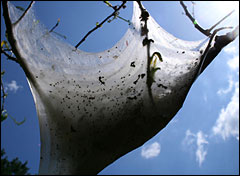Dear Umbra,
In beautiful Virginia, this is the time of year that the caterpillars start making their “tents” in branches of shrubbery and trees in our yards. Conventional wisdom has been to destroy them, as they will surely eat the leaves inside the tent, causing some damage to the infected tree/shrub. So I have two questions: First, are these “tent worms” (which are really caterpillars) a stage of a butterfly or a moth? Second, since butterfly populations are on the decline, should we leave these “tents” alone?
Greg
Springfield, Va.
Dearest Greg,
A few years back we had a huge tent caterpillar infestation in the Seattle area. My apex of revulsion from that summer occurred while ambling along a beach at the foot of a small tree-covered cliff. What’s that soft, repeating, plopping noise we hear? Oh, just the caterpillars falling off the trees atop the cliff, down to our feet. They were pushed out of the overcrowded trees and fell to their doom, summer’s hairy larval rain.
Fortunately for the sanity of us all, not every year is a festival of writhing fuzz. The tent caterpillars of North America have boom and bust cycles, related to food supply and other population limiting factors.
Tent caterpillars are the larval stage of a moth (genus Malacosoma). Moths go through “complete” metamorphosis, with the life stages of egg, larva, pupa (aka cocoon), and adult. While the majority of insects have a complete metamorphosis, in my opinion incomplete metamorphosis (egg, nymph, adult) is the big thrill. Larvae just aren’t quite as exciting as nymphs, except the ladybug larva — but I digress. There are several types of tent caterpillar, such as Eastern, Forest Tent, and Western, which all have similar habits — though the Forest Tent does not spin the notorious tent, per se. They are native to North America! We should be proud.
Tent caterpillar eggs overwinter in an egg mass resembling a foam bracelet encircling a twig. This stage is the easiest to remove from the tree, by scraping off the eggs or pruning the twig. Next, the caterpillars emerge and begin to bulk up for pupation by eating everything in sight. If they weren’t caterpillars, we might think they were adorably puppyish: the larvae stay together in their homemade tent nest, cuddling with each other at night and following each other’s slime trails along the tree branch during the day (lovably falling to the ground on occasion). I’m sure they are cutely floppy in their own way. After about a month and a half of wiggling, eating, pooping, and munching, they pupate, become fuzzy brown moths, lay the foam egg bracelet, and die.
As we have all experienced, plentiful tent caterpillar populations are daunting, disgusting, and appear horrible for trees. Although a boom year for caterpillars can denude trees, the trees will usually recover, sending out a second set of leaves and only suffering a bit of a setback in their growth. The denudation can actually benefit smaller trees lower in the canopy, which may receive more sunlight than usual and experience a good year of growth. The bountiful caterpillars will provide a plethora of food for their predators and poop for the forest floor. A few years in a row of boom population, however, and trees may start having trouble. So if you are on the fence about destroying the caterpillars, and it’s year one, you have reason to stay your hand.
If you can’t abide by the caterpillars in your home landscape, I think you have license to destroy them as best you are able. Do not use fire. Scrape or prune off the egg masses in the winter or early spring. Once the tents pop up, scrape or prune these off the branches and plop them into a bucket of soapy water. When the caterpillars appear to be dead, dump them into the bushes. Be careful that your anti-caterpillar pruning does not damage the tree, leave it misshapen, or remove too much wood. If you don’t know the general rules of tree pruning, please take a moment to visit the library or internet and learn about how to approach pruning your particular tree. Please.
Wiggly,
Umbra


